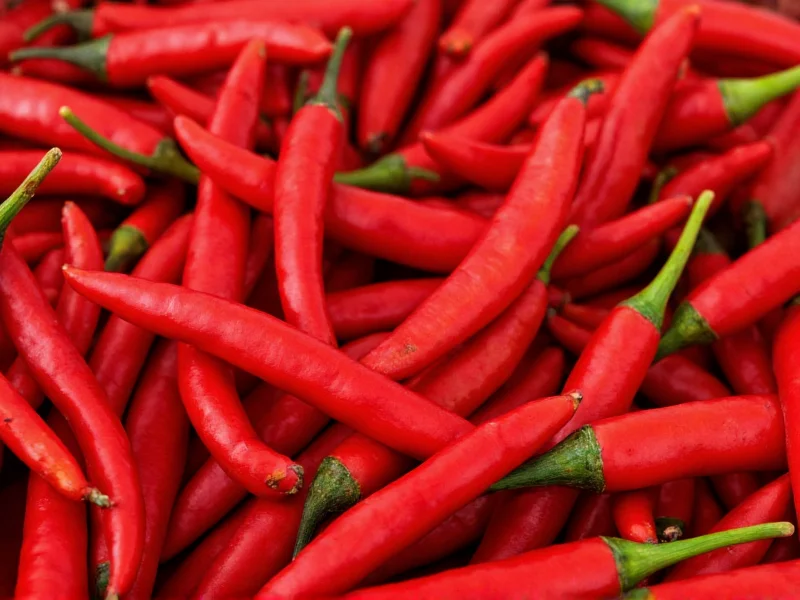When exploring are red chilis hot, it's essential to understand that chili color primarily indicates ripeness rather than heat level. As chilis mature from green to red, their chemical composition changes, but this doesn't automatically make them hotter. The misconception that red chilis are always hotter than green ones persists in culinary circles, yet the reality is far more nuanced.
The Science Behind Chili Heat
Chili heat comes from capsaicinoids, primarily capsaicin, which activate pain receptors in our mouths. These compounds concentrate in the placenta (the white ribs inside the pepper), not the seeds as commonly believed. The Scoville scale measures heat intensity, ranging from 0 (bell peppers) to over 2 million units (Carolina Reaper).
Color change from green to red occurs as chlorophyll breaks down and carotenoids develop during ripening. While some varieties do become slightly hotter as they mature, others maintain similar heat levels or even decrease in spiciness. The genetic makeup of each chili variety determines its potential heat range more than its color.
Factors That Actually Determine Chili Heat
Several elements influence a chili's spiciness beyond its color:
| Factor | Impact on Heat Level |
|---|---|
| Chili Variety | Determines the genetic potential for heat (e.g., habanero vs. bell pepper) |
| Environmental Stress | Drought or nutrient deficiency can increase capsaicin production |
| Ripeness Stage | Some varieties peak in heat at certain maturity stages |
| Soil Composition | Mineral content affects capsaicinoid development |
| Climate Conditions | Warmer temperatures generally produce hotter chilis |
Common Misconceptions About Red Chilis
Many home cooks operate under false assumptions about red chilis and heat. Let's clarify these are all red chilis hot misconceptions:
- Myth: Red chilis are always hotter than green ones of the same variety
Fact: While some varieties like jalapeños develop slightly more capsaicin as they ripen, the difference is minimal. The flavor profile changes more significantly than the heat level. - Myth: The seeds make chilis hot
Fact: Capsaicin concentrates in the placenta (white ribs). Seeds only become spicy through contact with these ribs. - Myth: Brighter red color means hotter pepper
Fact: Color intensity relates to carotenoid development, not capsaicin content. Some extremely hot chilis like the red savina habanero have deep color, while mild paprika peppers are also vibrant red.
Red Chili Varieties and Their Actual Heat Levels
Understanding what makes red chilis hot requires examining specific varieties. Here's a comparison of common red chilis and their Scoville ratings:
| Chili Variety | Color When Mature | Scoville Heat Units | Heat Level |
|---|---|---|---|
| Bell Pepper | Red, yellow, orange | 0 SHU | Mild (not hot) |
| Cherry Pepper | Bright red | 100-500 SHU | Very mild |
| Poblano (Ancho when dried) | Dark red when mature | 1,000-2,000 SHU | Mild to medium |
| Jalapeño | Bright red when mature | 2,500-8,000 SHU | Medium |
| Cayenne | Bright red | 30,000-50,000 SHU | Hot |
| Habanero | Red, orange, yellow | 100,000-350,000 SHU | Very hot |
| Ghost Pepper (Bhut Jolokia) | Bright red | 800,000-1,041,427 SHU | Extremely hot |
Practical Implications for Cooks and Gardeners
When working with red chilis, consider these practical insights about why are some red chilis not hot while others burn:
For gardeners: Heat levels can vary significantly even within the same plant based on environmental factors. If growing chilis for specific heat levels, maintain consistent watering and avoid extreme stress unless seeking maximum capsaicin production.
For cooks: Don't judge a red chili's heat by its color alone. Sample a tiny piece before adding to dishes. Remember that cooking can mellow heat slightly, while drying often concentrates capsaicin. When substituting chilis in recipes, focus on variety rather than color to maintain intended heat levels.
Understanding types of red chilis and their heat levels helps prevent culinary disasters. For example, substituting a mild red bell pepper for a hot red cayenne would dramatically alter a dish's flavor profile. Always research specific varieties rather than assuming based on color.
Measuring and Managing Chili Heat
Professional kitchens and food scientists use several methods to assess and control chili heat:
- Scoville Organoleptic Test: Human testers dilute chili extract until heat is undetectable
- HPLC (High-Performance Liquid Chromatography): Scientific method measuring exact capsaicinoid concentrations
- Heat mitigation techniques: Dairy products (casein), sugar, and acidic ingredients can counteract capsaicin's effects
When working with extremely hot red chilis like ghost peppers or Carolina Reapers, wear gloves and avoid touching your face. The capsaicin concentration in these varieties can cause skin irritation and respiratory issues.
Conclusion: Beyond the Color Myth
The question are red chilis hot reveals a common culinary misconception. Color indicates ripeness stage, not heat potential. Both mild and extremely hot chilis can appear red at maturity. The key to understanding chili heat lies in recognizing specific varieties, growing conditions, and the biological factors affecting capsaicin production. Whether you're selecting chilis at the market or growing them in your garden, focus on variety identification rather than color to predict heat levels accurately.











 浙公网安备
33010002000092号
浙公网安备
33010002000092号 浙B2-20120091-4
浙B2-20120091-4